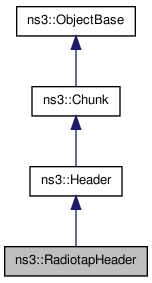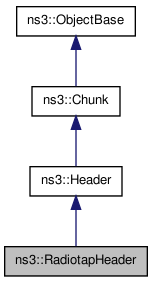Radiotap header implementation. More...
#include <radiotap-header.h>


Public Types | |
| enum | { FRAME_FLAG_NONE = 0x00, FRAME_FLAG_CFP = 0x01, FRAME_FLAG_SHORT_PREAMBLE = 0x02, FRAME_FLAG_WEP = 0x04, FRAME_FLAG_FRAGMENTED = 0x08, FRAME_FLAG_FCS_INCLUDED = 0x10, FRAME_FLAG_DATA_PADDING = 0x20, FRAME_FLAG_BAD_FCS = 0x40, FRAME_FLAG_SHORT_GUARD = 0x80 } |
| enum | { CHANNEL_FLAG_NONE = 0x0000, CHANNEL_FLAG_TURBO = 0x0010, CHANNEL_FLAG_CCK = 0x0020, CHANNEL_FLAG_OFDM = 0x0040, CHANNEL_FLAG_SPECTRUM_2GHZ = 0x0080, CHANNEL_FLAG_SPECTRUM_5GHZ = 0x0100, CHANNEL_FLAG_PASSIVE = 0x0200, CHANNEL_FLAG_DYNAMIC = 0x0400, CHANNEL_FLAG_GFSK = 0x0800 } |
Public Member Functions | |
| virtual TypeId | GetInstanceTypeId (void) const |
| virtual uint32_t | GetSerializedSize (void) const |
| virtual void | Serialize (Buffer::Iterator start) const |
| virtual uint32_t | Deserialize (Buffer::Iterator start) |
| virtual void | Print (std::ostream &os) const |
| void | SetTsft (uint64_t tsft) |
| Set the Time Synchronization Function Timer (TSFT) value. Valid for received frames only. | |
| uint64_t | GetTsft (void) const |
| Get the Time Synchronization Function Timer (TSFT) value. Valid for received frames only. | |
| void | SetFrameFlags (uint8_t flags) |
| Set the frame flags of the transmitted or received frame. | |
| uint8_t | GetFrameFlags (void) const |
| Get the frame flags of the transmitted or received frame. | |
| void | SetRate (uint8_t rate) |
| Set the transmit/receive channel frequency in units of megahertz. | |
| uint8_t | GetRate (void) const |
| Get the transmit/receive channel frequency in units of megahertz. | |
| void | SetChannelFrequencyAndFlags (uint16_t frequency, uint16_t flags) |
| Set the transmit/receive channel frequency and flags. | |
| uint16_t | GetChannelFrequency (void) const |
| Get the transmit/receive data rate in units of 500 kbps. | |
| uint16_t | GetChannelFlags (void) const |
| Get the channel flags of the transmitted or received frame. | |
| void | SetAntennaSignalPower (int8_t signal) |
| Set the RF signal power at the antenna as a decibel difference from an arbitrary, fixed reference. | |
| void | SetAntennaSignalPower (double signal) |
| Set the RF signal power at the antenna as a decibel difference from an arbitrary, fixed reference. | |
| uint8_t | GetAntennaSignalPower (void) const |
| Get the RF signal power at the antenna as a decibel difference from an arbitrary, fixed reference. | |
| void | SetAntennaNoisePower (int8_t noise) |
| Set the RF noise power at the antenna as a decibel difference from an arbitrary, fixed reference. | |
| void | SetAntennaNoisePower (double noise) |
| Set the RF noise power at the antenna as a decibel difference from an arbitrary, fixed reference. | |
| uint8_t | GetAntennaNoisePower (void) const |
| Get the RF noise power at the antenna as a decibel difference from an arbitrary, fixed reference. | |
Static Public Member Functions | |
| static TypeId | GetTypeId (void) |
| This method returns the TypeId associated to ns3::RadiotapHeader. | |
Detailed Description
Radiotap header implementation.
Radiotap is a de facto standard for 802.11 frame injection and reception. The radiotap header format is a mechanism to supply additional information about frames, from the driver to userspace applications such as libpcap, and from a userspace application to the driver for transmission.
- Warning:
- the radiotap header specification says that the fields included in the header should be aligned to their natural ize (e.g., 16-bit fields aligned to 16-bit boundaries, 32-bit fields aligned to 32-bit boundaries, and so on. This implementation does not enforce this. However, the radiotap specification enforces an order in which fields have to appear (if they appear), and this ordering is such that, provided you don't leave gaps, all fields will end up aligned without the need of inserting padding space. By the term "gap" I mean not using a field which would appear between two used fields. Moral: don't leave gaps, or if you do be careful about how you do it.
Member Enumeration Documentation
| anonymous enum |
- Enumerator:
| anonymous enum |
- Enumerator:
CHANNEL_FLAG_NONE No flags set
CHANNEL_FLAG_TURBO Turbo Channel
CHANNEL_FLAG_CCK CCK channel
CHANNEL_FLAG_OFDM OFDM channel
CHANNEL_FLAG_SPECTRUM_2GHZ 2 GHz spectrum channel
CHANNEL_FLAG_SPECTRUM_5GHZ 5 GHz spectrum channel
CHANNEL_FLAG_PASSIVE Only passive scan allowed
CHANNEL_FLAG_DYNAMIC Dynamic CCK-OFDM channel
CHANNEL_FLAG_GFSK GFSK channel (FHSS PHY)
Member Function Documentation
| virtual uint32_t ns3::RadiotapHeader::Deserialize | ( | Buffer::Iterator | start | ) | [virtual] |
This method is used by Packet::RemoveHeader to re-create a header from the byte buffer of a packet. The data read is expected to match bit-for-bit the representation of this header in real networks.
- Parameters:
-
start An iterator which points to where the header should written.
- Returns:
- The number of bytes read.
Implements ns3::Header.
| uint8_t ns3::RadiotapHeader::GetAntennaNoisePower | ( | void | ) | const |
Get the RF noise power at the antenna as a decibel difference from an arbitrary, fixed reference.
- Returns:
- The RF noise power at the antenna as a decibel difference from an arbitrary, fixed reference.
| uint8_t ns3::RadiotapHeader::GetAntennaSignalPower | ( | void | ) | const |
Get the RF signal power at the antenna as a decibel difference from an arbitrary, fixed reference.
- Returns:
- The RF signal power at the antenna as a decibel difference from an arbitrary, fixed reference.
| uint16_t ns3::RadiotapHeader::GetChannelFlags | ( | void | ) | const |
Get the channel flags of the transmitted or received frame.
- Returns:
- The frame flags.
- See also:
- ChannelFlags.
| uint16_t ns3::RadiotapHeader::GetChannelFrequency | ( | void | ) | const |
Get the transmit/receive data rate in units of 500 kbps.
- Returns:
- The transmit/receive data rate in units of 500 kbps.
| uint8_t ns3::RadiotapHeader::GetFrameFlags | ( | void | ) | const |
Get the frame flags of the transmitted or received frame.
- Returns:
- The frame flags.
- See also:
- FrameFlags.
| virtual TypeId ns3::RadiotapHeader::GetInstanceTypeId | ( | void | ) | const [virtual] |
- Returns:
- the TypeId associated to the most-derived type of this instance.
This method is typically implemented by ns3::Object::GetInstanceTypeId but some classes which derive from ns3::ObjectBase directly have to implement it themselves.
Implements ns3::ObjectBase.
| uint8_t ns3::RadiotapHeader::GetRate | ( | void | ) | const |
Get the transmit/receive channel frequency in units of megahertz.
- Returns:
- The transmit/receive channel frequency in units of megahertz.
| virtual uint32_t ns3::RadiotapHeader::GetSerializedSize | ( | void | ) | const [virtual] |
This method is used by Packet::AddHeader to store the header into the byte buffer of a packet. This method returns the number of bytes which are needed to store the header data during a Serialize.
- Returns:
- The expected size of the header.
Implements ns3::Header.
| uint64_t ns3::RadiotapHeader::GetTsft | ( | void | ) | const |
| static TypeId ns3::RadiotapHeader::GetTypeId | ( | void | ) | [static] |
This method returns the TypeId associated to ns3::RadiotapHeader.
No Attributes defined for this type.
No TraceSources defined for this type.
Reimplemented from ns3::Header.
| virtual void ns3::RadiotapHeader::Print | ( | std::ostream & | os | ) | const [virtual] |
This method is used by Packet::Print to print the content of the header as ascii data to a C++ output stream. Although the header is free to format its output as it wishes, it is recommended to follow a few rules to integrate with the packet pretty printer: start with flags, small field values located between a pair of parens. Values should be separated by whitespace. Follow the parens with the important fields, separated by whitespace.
eg: (field1 val1 field2 val2 field3 val3) field4 val4 field5 val5
- Parameters:
-
os The output stream
Implements ns3::Header.
| virtual void ns3::RadiotapHeader::Serialize | ( | Buffer::Iterator | start | ) | const [virtual] |
This method is used by Packet::AddHeader to store the header into the byte buffer of a packet. The data written is expected to match bit-for-bit the representation of this header in a real network.
- Parameters:
-
start An iterator which points to where the header should be written.
Implements ns3::Header.
| void ns3::RadiotapHeader::SetAntennaNoisePower | ( | double | noise | ) |
Set the RF noise power at the antenna as a decibel difference from an arbitrary, fixed reference.
- Parameters:
-
noise The RF noise power at the antenna as a decibel difference from an arbitrary, fixed reference.
| void ns3::RadiotapHeader::SetAntennaNoisePower | ( | int8_t | noise | ) |
Set the RF noise power at the antenna as a decibel difference from an arbitrary, fixed reference.
- Parameters:
-
noise The RF noise power at the antenna as a decibel difference from an arbitrary, fixed reference.
| void ns3::RadiotapHeader::SetAntennaSignalPower | ( | int8_t | signal | ) |
Set the RF signal power at the antenna as a decibel difference from an arbitrary, fixed reference.
- Parameters:
-
signal The RF signal power at the antenna as a decibel difference from an arbitrary, fixed reference.
| void ns3::RadiotapHeader::SetAntennaSignalPower | ( | double | signal | ) |
Set the RF signal power at the antenna as a decibel difference from an arbitrary, fixed reference.
- Parameters:
-
signal The RF signal power at the antenna as a decibel difference from an arbitrary, fixed reference;
| void ns3::RadiotapHeader::SetChannelFrequencyAndFlags | ( | uint16_t | frequency, | |
| uint16_t | flags | |||
| ) |
Set the transmit/receive channel frequency and flags.
- Parameters:
-
frequency The transmit/receive data rate in units of 500 kbps. flags The flags to set.
- See also:
- ChannelFlags
| void ns3::RadiotapHeader::SetFrameFlags | ( | uint8_t | flags | ) |
Set the frame flags of the transmitted or received frame.
- Parameters:
-
flags flags to set.
| void ns3::RadiotapHeader::SetRate | ( | uint8_t | rate | ) |
Set the transmit/receive channel frequency in units of megahertz.
- Parameters:
-
rate the transmit/receive channel frequency in units of megahertz.
| void ns3::RadiotapHeader::SetTsft | ( | uint64_t | tsft | ) |
The documentation for this class was generated from the following files:
- src/node/radiotap-header.h
- doc/introspected-doxygen.h
 1.7.1
1.7.1